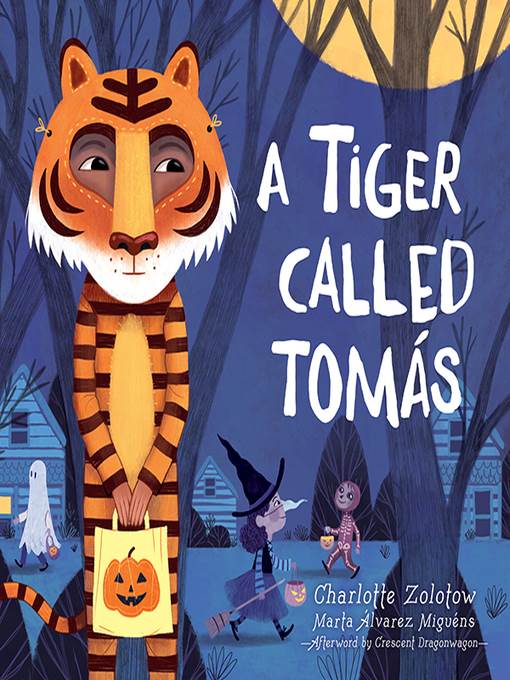
A Tiger Called Tomás
فرمت کتاب
ebook
تاریخ انتشار
2018
Lexile Score
510
Reading Level
0-2
ATOS
3.1
Interest Level
K-3(LG)
نویسنده
Marta Alvarez Miguensناشر
Sourcebooksشابک
9781492601739
کتاب های مرتبط
- اطلاعات
- نقد و بررسی
- دیدگاه کاربران
نقد و بررسی

July 2, 2018
First published in 1963 and reissued twice since then, this story about a little boy who worries that no one will like him has been illustrated in various ways. In this fourth version, Tomás is Latino, and touches of Spanish alter the text: “Why shouldn’t they like you?” Tomás’s mother asks him, “Por qué no?” When Halloween comes, she presents him with a tiger costume, and the disguise gives Tomás the courage he needs to venture forth. Colorful artwork by Miguéns (Shark Lady) concentrates on eyes and on looking: Tomás’s lonely gaze from the steps, his mother’s conspiratorial glance as she brings home his costume, the eyes he sees in the mirror through his mask, and the welcoming looks of his neighbors on Halloween night. Zolotow’s fine, sensitive writing captures the power that dressing up gives Tomás. Young readers know how magical wearing a costume feels, and they’ll be amused by the way all the neighbors seem to know Tomás—and warmly greet him, despite his disguise—in this successful reboot. Ages 3–6.

July 1, 2018
PreS-Gr 2-When a young boy moves into a new neighborhood, he's afraid he might not be liked. First published in 1963, this latest edition of the timeless classic sees the little boy's name change from Thomas to Tomás and his family is a Spanish speaking one. Tomás sits on his stoop and watches the comings and goings of his neighbors: Marie, who likes to play hopscotch; the lady with the black cat who lives down the street; Gerald, the tall boy who looks lonely; the lady across the street who likes to work in the garden; and the old man who walks his poodle past Tomás' house everyday. Yet, in spite of encouragement from his mom, Tomás will not leave his stoop. All this changes on Halloween, when, disguised as a tiger, he goes trick-or-treating. Tomás finds his neighbors are nice and friendly; they all ask him to come back, and best of all, they all know his name. Suddenly he feels wonderful... maravilloso. Alvarez's full-bleed, playful illustrations are warm and colorful, further reinforcing the emotion of the tale. There is an afterword by Crescent Dragonwagon, Zolotow's daughter. VERDICT In our highly mobile society, many children will identify with Tomás' newcomer feelings of insecurity. Share this classic story one-on-one or in a group for discussion.-Lucia Acosta, Children's Literature Specialist, Princeton, NJ
Copyright 2018 School Library Journal, LLC Used with permission.

August 1, 2018
The story of a shy child and a Halloween costume that helps him connect with new neighbors is reinterpreted again, 55 years after its original publication as A Tiger Called Thomas with illustrations by Kurt Werth.Tomás stays on the stoop of his new home every day as potential friends pass by, convinced "that the new people might not like him." The gnawing feeling that he won't be embraced by the neighborhood worsens until Halloween, when he puts on a tiger costume and disguises himself to meet them all. Of course, the costume doesn't do much to hide his identity; everyone knows it's Tomás, to his surprise. But the interactions help him connect in ways he wouldn't otherwise. The boy and his mother, who are bilingual and presumed Latinx, speak mostly in English with a little Spanish sprinkled in, a hint that a language or cultural barrier may be adding to his shyness. But the Spanish is light at best, mostly parroting English words; it's not a convincing reason for Tomás' isolation. Nevertheless, his story rings true, as it has in previous versions of the late author's story. The illustrations, especially those of melancholy Tomás and his colorful costume, are warm without being cloying, particularly the first time readers see him smile (which happens to be on the last page).A must-read for introverted kids, it's a worthy update to the 1963 original. (afterword) (Picture book. 4-8)
COPYRIGHT(2018) Kirkus Reviews, ALL RIGHTS RESERVED.

























دیدگاه کاربران